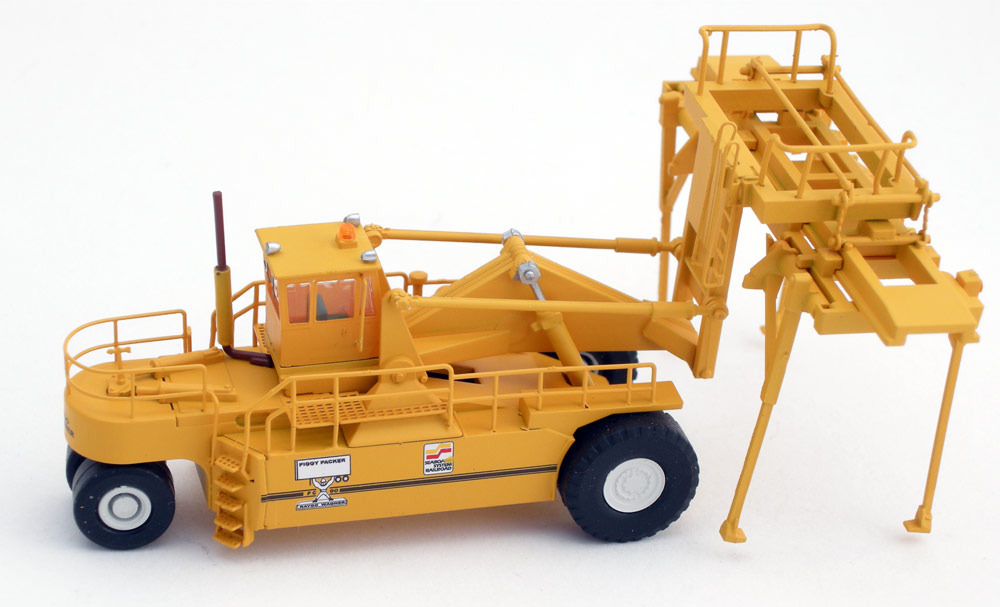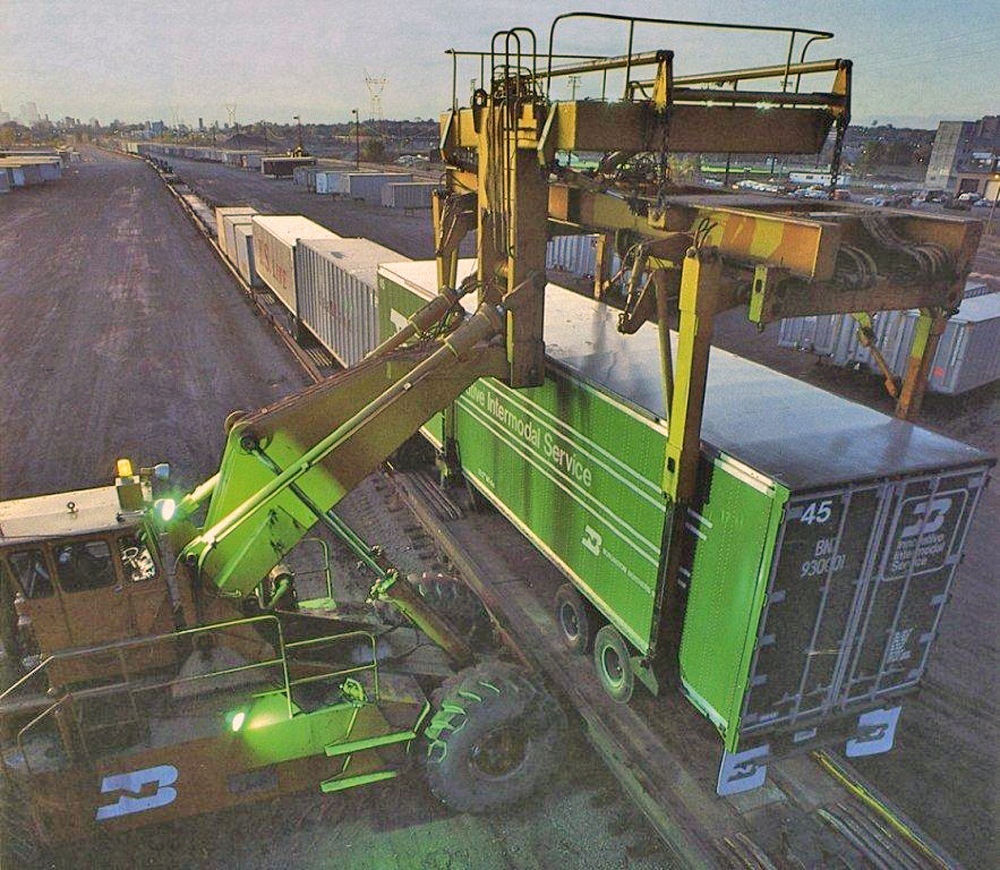Specific Item Information:
CSX/Seaboard System "Seaboard System RR" logo, mid-late model with bottom lift
CSX/Seaboard System "Seaboard System RR" logo, mid-late model with bottom lift
Prototype History: By the early 1960s, railroads in North America were routinely transporting truck trailers on specialized railroad cars called “piggyback” flat cars (known as Trailer On Flat Car, or TOFC). The loading and unloading of truck trailers from these flat cars was accomplished by way of a ramp at one end of the train, with a truck-tractor used to pull the trailer on and off the train. This was commonly referred to as “circus loading”, and was a time consuming process: by this method, trailers on piggyback flat cars could only be loaded or unloaded sequentially. Furthermore circus loading required a very skilled driver, one able to navigate the narrow confines of a flatcar, especially when backing up to pick up a trailer.
In 1968, the FWD Wagner Corp. developed the P-80 and the PC-90. The boom on the PC-90 (and P-80) was redesigned to eliminate the tilting of the trailers during lifting by including a pair of horizontal stabilizing bars that served as a parallelogram. Folding grapple arms replaced the clamshell lift mechanism, eliminating the 10-feet clearance required with the '70. Further, by 1968, ISO standards had been established for the emerging maritime container business, replacing the proprietary lift mechanisms for SeaLand, Matson and others. Nelson saw the growth potential in adapting the Piggy-Packer for container handling, and chose the lift mechanism that had been developed by Ropco Corp. The first dual-purpose machine equipped with a container spreader entered service in UP’s Seattle facility in 1968. Furthermore, lift capacity was beefed up to 90,000 lb (45 tons). The PC-90 quickly became the de facto standard for mechanization of TOFC operations.
In 1968, the FWD Wagner Corp. developed the P-80 and the PC-90. The boom on the PC-90 (and P-80) was redesigned to eliminate the tilting of the trailers during lifting by including a pair of horizontal stabilizing bars that served as a parallelogram. Folding grapple arms replaced the clamshell lift mechanism, eliminating the 10-feet clearance required with the '70. Further, by 1968, ISO standards had been established for the emerging maritime container business, replacing the proprietary lift mechanisms for SeaLand, Matson and others. Nelson saw the growth potential in adapting the Piggy-Packer for container handling, and chose the lift mechanism that had been developed by Ropco Corp. The first dual-purpose machine equipped with a container spreader entered service in UP’s Seattle facility in 1968. Furthermore, lift capacity was beefed up to 90,000 lb (45 tons). The PC-90 quickly became the de facto standard for mechanization of TOFC operations.
Road Name History: CSX Transportation (reporting mark CSXT) is a Class I railroad in the United States. The main subsidiary of the CSX Corporation, the railroad is headquartered in Jacksonville, Florida, and owns about 21,000 route miles (34,000 km). CSX operates one of the three Class I railroads serving most of the East Coast, the other two being the Norfolk Southern Railway (NS) and Canadian Pacific Railway. It also serves the Canadian provinces of Ontario and Quebec. Together CSX and Norfolk Southern Railway have a duopoly over all east-west freight rail traffic east of the Mississippi River. As of October 1, 2014 CSX's total public stock value was slightly over $32 billion.
CSX Transportation was formed on November 1, 1980, by combining the railroads of the former Chessie System with Seaboard Coast Line Industries, and finally with the Seaboard System Railroad in 1986. The originator of the Seaboard System was the former Seaboard Air Line Railroad, which previously merged with the Atlantic Coast Line Railroad in 1967, and later with the Louisville & Nashville Railroad, as well as several smaller subsidiaries such as the Clinchfield Railroad, Atlanta & West Point Railroad, Monon Railroad and the Georgia Railroad. The origin of the Chessie System was the former Chesapeake & Ohio Railway, which had merged with the Baltimore & Ohio Railroad, and the Western Maryland Railway.
Read more on Wikipedia.
CSX Transportation was formed on November 1, 1980, by combining the railroads of the former Chessie System with Seaboard Coast Line Industries, and finally with the Seaboard System Railroad in 1986. The originator of the Seaboard System was the former Seaboard Air Line Railroad, which previously merged with the Atlantic Coast Line Railroad in 1967, and later with the Louisville & Nashville Railroad, as well as several smaller subsidiaries such as the Clinchfield Railroad, Atlanta & West Point Railroad, Monon Railroad and the Georgia Railroad. The origin of the Chessie System was the former Chesapeake & Ohio Railway, which had merged with the Baltimore & Ohio Railroad, and the Western Maryland Railway.
Read more on Wikipedia.
Brand/Importer Information: Wheels of Time was founded by Matthew Young in the fall of 1995. From an early age, Matthew has had a passion for trains, both in full-size and in miniature. His family frequently went out of their way so he could ride the train, or simply watch the action on the tracks. "On one occasion mom took us to San Francisco along the waterfront. Spotting a State Belt ALCo S-2 locomotive switching the wharves, I persuading my mom to follow it. I watched in wonder as I saw and heard the hit-cup sputtering of the ALCo engine as it revved-up to move railroad cars on and off the car float at Pier 43." Other early family experiences included watching Southern Pacific freight and Amtrak's San Joaquin Amfleet trains roll by as his family waited to be seated at Spenger's in Berkeley, which sat happily right next to the tracks. "My brother and I would shoot pictures of the trains with our Instantmatic 110 cameras, sometimes only getting the wheels or worse yet ... getting a real good close up of my big thumb."
Matthew and his brother built models of all kinds, but their model train career began in elementary school when they started making 3-D cardboard miniature trains from pictures found in the pages of Trains Magazine and Model Railroader Magazine. On a visit, many years later, with the late Richard Buike of Trackside Trains in Burlingame, California, the conversation turned to the lack of N-Scale passenger trains and how the few that existed didn't look right. "I told him right then and there that I was going to produce high quality, historically accurate passenger railroad cars. Even I was a little surprised when I said this." The first product was a 1950 Pullman-Standard "10-6" sleeping car made of brass. Wheels of Time became one of the first makers of historically accurate and realisticly detailed passenger train cars. At Wheels of Time, we research original equipment and recreate it with CAD software for production. We're lovers of history and sticklers for detail. On our line of Transit Motor Coaches (a fancy way of saying "buses"), even the destination *roll* signs are historically accurate. Be sure to check out all our beautiful and accurate products. We hope you'll come to share our passion for trains, here recreated in miniature. At Wheels of Time, you get to take home a piece of a fascinating history.
Wheels of Time manufactures historically accurate model trains, vehicles, and model railroad accessories with a real *wow* factor. Our obsession with detail and historical accuracy is reflected in our exceptional design and production: hold a Wheels of Time model in your hand and you'll be tempted to say, 'It's the real thing!'
Matthew and his brother built models of all kinds, but their model train career began in elementary school when they started making 3-D cardboard miniature trains from pictures found in the pages of Trains Magazine and Model Railroader Magazine. On a visit, many years later, with the late Richard Buike of Trackside Trains in Burlingame, California, the conversation turned to the lack of N-Scale passenger trains and how the few that existed didn't look right. "I told him right then and there that I was going to produce high quality, historically accurate passenger railroad cars. Even I was a little surprised when I said this." The first product was a 1950 Pullman-Standard "10-6" sleeping car made of brass. Wheels of Time became one of the first makers of historically accurate and realisticly detailed passenger train cars. At Wheels of Time, we research original equipment and recreate it with CAD software for production. We're lovers of history and sticklers for detail. On our line of Transit Motor Coaches (a fancy way of saying "buses"), even the destination *roll* signs are historically accurate. Be sure to check out all our beautiful and accurate products. We hope you'll come to share our passion for trains, here recreated in miniature. At Wheels of Time, you get to take home a piece of a fascinating history.
Wheels of Time manufactures historically accurate model trains, vehicles, and model railroad accessories with a real *wow* factor. Our obsession with detail and historical accuracy is reflected in our exceptional design and production: hold a Wheels of Time model in your hand and you'll be tempted to say, 'It's the real thing!'
Item created by: Powderman on 2018-11-19 10:51:17. Last edited by CNW400 on 2020-06-05 19:00:22
If you see errors or missing data in this entry, please feel free to log in and edit it. Anyone with a Gmail account can log in instantly.
If you see errors or missing data in this entry, please feel free to log in and edit it. Anyone with a Gmail account can log in instantly.











